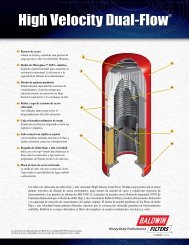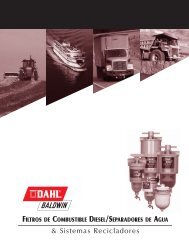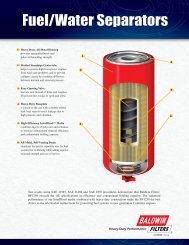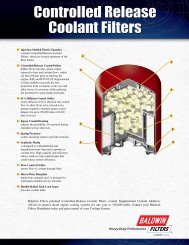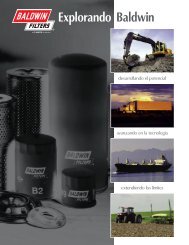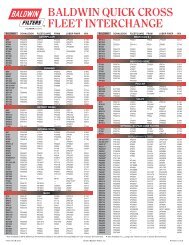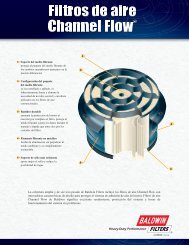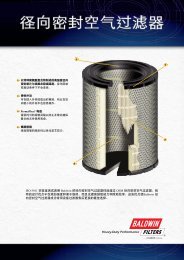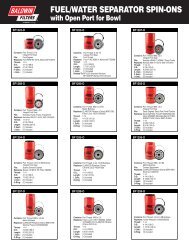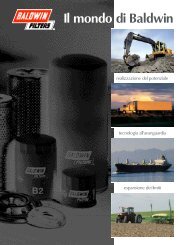ISO Updates to Multi-pass Oil Filter Test Procedures (pdf) - GXE
ISO Updates to Multi-pass Oil Filter Test Procedures (pdf) - GXE
ISO Updates to Multi-pass Oil Filter Test Procedures (pdf) - GXE
You also want an ePaper? Increase the reach of your titles
YUMPU automatically turns print PDFs into web optimized ePapers that Google loves.
Technical Service Bulletin 04-2R1<br />
<strong>ISO</strong> <strong>Updates</strong> <strong>to</strong> <strong>Multi</strong>-<strong>pass</strong> <strong>Oil</strong> <strong>Filter</strong> <strong>Test</strong><br />
<strong>Procedures</strong><br />
The <strong>ISO</strong> (International Organization for Standardization) standard for multi-<strong>pass</strong><br />
testing provides a common testing format for filter manufacturers <strong>to</strong> rate liquid<br />
filter performance. This standardization gives you the ability <strong>to</strong> reliably compare<br />
published filter (ß) beta ratios among different brands of filters, rather than relying<br />
on micron ratings. <strong>ISO</strong> test standard 4572 was replaced in 1999 by <strong>ISO</strong> 16889,<br />
which reflects the improved technology available in particle counters and other<br />
test equipment. The newer particle counters provide more precise counting and<br />
greater detail -- reflecting a truer indication of filter performance. <strong>ISO</strong> only issues<br />
test procedures <strong>to</strong> standardize filter testing, which allows the results <strong>to</strong> be<br />
comparable. <strong>ISO</strong> does not actually perform any commercial product testing, nor<br />
do they specify filter performance requirements.<br />
Better <strong>Test</strong> Dust: The old test dust (AC fine test dust or ACFTD) was "ball<br />
milled," which produced dust particles of varying size and shape. Particle<br />
distribution was often different from batch <strong>to</strong> batch. The accuracy of ACFTD<br />
distribution and previous au<strong>to</strong>matic particle counting calibration procedures was<br />
questioned by the industry, due <strong>to</strong> lack of traceability and certification. ACFTD<br />
has not been produced since 1992. Now, the new test dust (<strong>ISO</strong> medium test<br />
dust) is "jet milled" <strong>to</strong> produce consistent particle size, shape, and distribution<br />
from batch <strong>to</strong> batch (see dust size comparison chart below). The old particle<br />
counter calibration was based on only one dimension of an irregularly-shaped<br />
particle (the longest cord). Today, the particle counter calibration is based on<br />
equivalent spherical area of an irregularly-shaped particle.<br />
National Institute of Standards and Technology (NIST) provides calibration<br />
suspension, which is certified with X number of particles at a certain size. This is<br />
verified by NIST. The new way <strong>to</strong> list (ß) beta ratios includes a subscript (c) <strong>to</strong><br />
indicate NIST certified test suspension and assures you of traceability and<br />
repeatability. Overall, you can have strong confidence in liquid filter ratings<br />
resulting from tests per <strong>ISO</strong> 16889, as they are highly accurate. As always, keep<br />
in mind that beta ratings are labora<strong>to</strong>ry measurements under steady flow<br />
conditions with artificial contaminants - the real proof of the performance is how<br />
clean the filter keeps the fluids in the application. The consistent use of a fluid<br />
analysis program that checks the cleanliness of the fluid will verify that proper<br />
filters are being used.<br />
Revised Oc<strong>to</strong>ber 2004<br />
Page 1 of 2
<strong>ISO</strong> 16889 recommends reporting beta ratings at:<br />
Rating Efficiency<br />
Example: ß4(c) =<br />
200 signifies that<br />
there are 200 times<br />
as many particles<br />
that are 4µm and<br />
larger upstream as<br />
downstream. This is<br />
99.5% efficiency.<br />
For additional information, contact:<br />
<strong>Filter</strong> Manufacturers Council<br />
P.O. Box 13966<br />
Research Triangle Park, NC 27709-3966<br />
Phone: 919/406-8817 Fax: 919/406-1306<br />
www.filtercouncil.org<br />
Administered by Mo<strong>to</strong>r & Equipment Manufacturers Association<br />
Revised Oc<strong>to</strong>ber 2004<br />
Page 2 of 2




